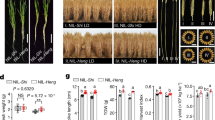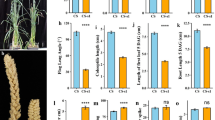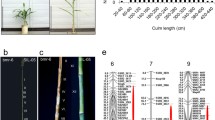Abstract
Key message
A recent study identified a natural deletion in the r-e-z haploblock which confers a semi-dwarf trait, higher nitrogen use efficiency, and improved yield in semi-dwarf wheat varieties by attenuating the brassinosteroid signaling.

Similar content being viewed by others
References
Bentley AR, Donovan J, Sonder K et al (2022) Near-to long-term measures to stabilize global wheat supplies and food security. Nat Food 3:483–486
Li J, Nagpal P, Vitart V et al (1996) A role for brassinosteroids in light-dependent development of Arabidopsis. Science 272:398–401
Liu Q, Wu K, Song W et al (2022) Improving crop nitrogen use efficiency toward sustainable green revolution. Annu Rev Plant Biol 73:523–551
Nam KH, Li J (2002) BRI1/BAK1, a receptor kinase pair mediating brassinosteroid signaling. Cell 110:203–212
Pearce S (2021) Towards the replacement of wheat ‘Green Revolution’genes. J Exp Bot 72:157–160
Peng J, Richards DE, Hartley NM et al (1999) ‘Green revolution’genes encode mutant gibberellin response modulators. Nature 400:256–261
Song L, Liu J, Cao B, et al (2023) Reducing brassinosteroid signalling enhances grain yield in semi-dwarf wheat. Nature 617:118–124
Tang T, Botwright Acuña T, Spielmeyer W, Richards RA (2021) Effect of gibberellin-sensitive Rht18 and gibberellin-insensitive Rht-D1b dwarfing genes on vegetative and reproductive growth in bread wheat. J Exp Bot 72:445–458
Wang J, Jiang J, Wang J et al (2014) Structural insights into the negative regulation of BRI1 signaling by BRI1-interacting protein BKI1. Cell Res 24:1328–1341
Funding
This work was supported by a grant from the National Research Foundation of Korea (NRF) funded by the Ministry of Education, Science, and Technology (grant no. RS-2023-00248352).
Author information
Authors and Affiliations
Contributions
RG conceived, wrote, and revised the manuscript.
Corresponding author
Ethics declarations
Conflict of interest
The authors have no competing interests to declare that are relevant to the content of this article.
Additional information
Communicated by Neal Stewart.
Publisher's Note
Springer Nature remains neutral with regard to jurisdictional claims in published maps and institutional affiliations.
Rights and permissions
Springer Nature or its licensor (e.g. a society or other partner) holds exclusive rights to this article under a publishing agreement with the author(s) or other rightsholder(s); author self-archiving of the accepted manuscript version of this article is solely governed by the terms of such publishing agreement and applicable law.
About this article
Cite this article
Gupta, R. Attenuation of brassinosteroid signaling enhances grain yield in semi-dwarf wheat varieties. Plant Cell Rep 43, 11 (2024). https://doi.org/10.1007/s00299-023-03113-7
Received:
Accepted:
Published:
DOI: https://doi.org/10.1007/s00299-023-03113-7




